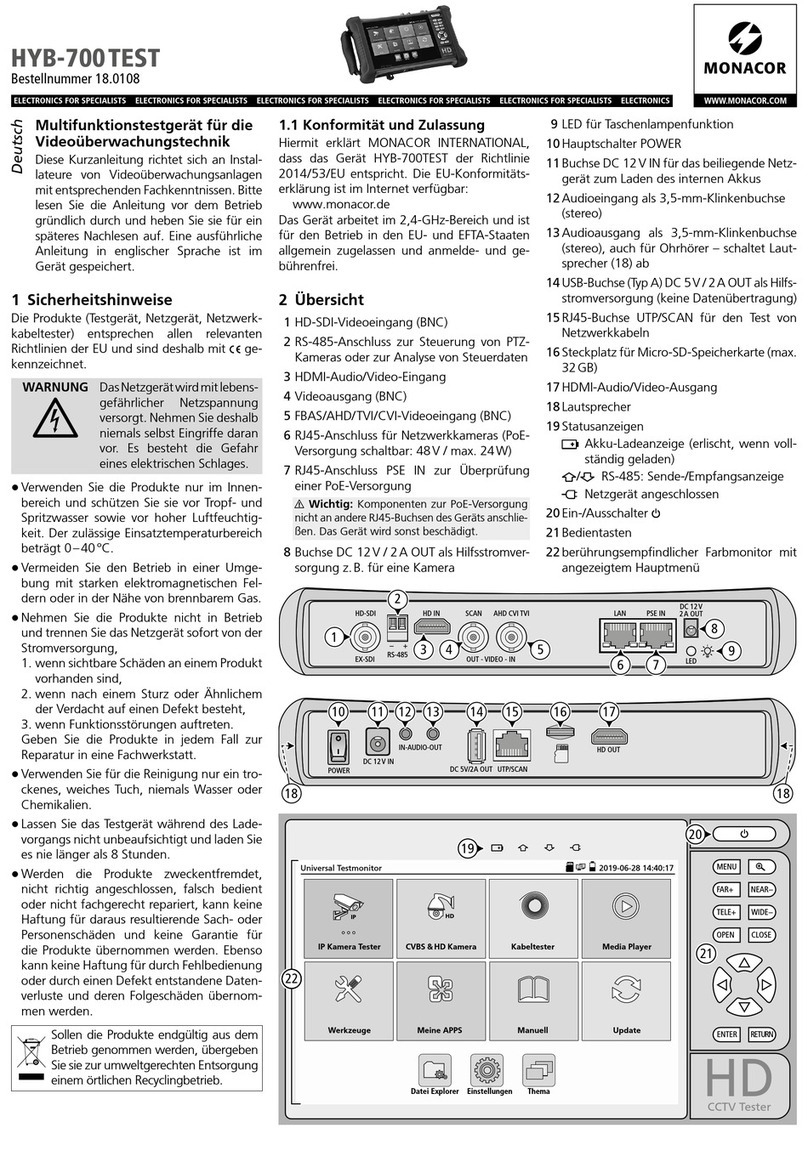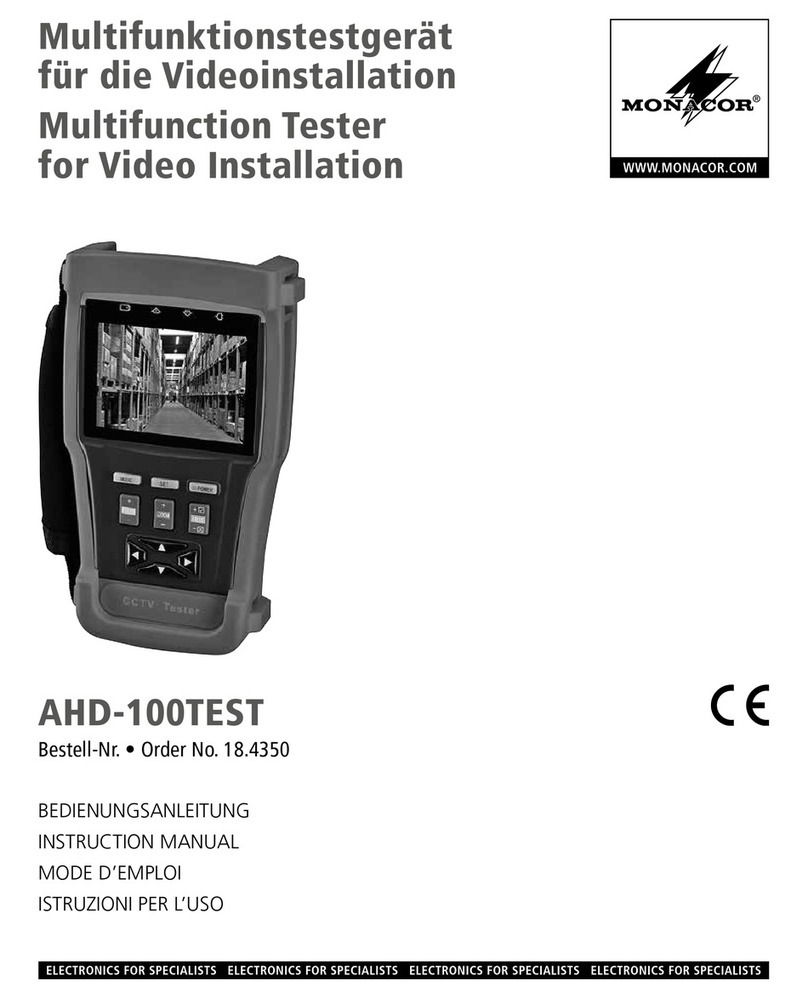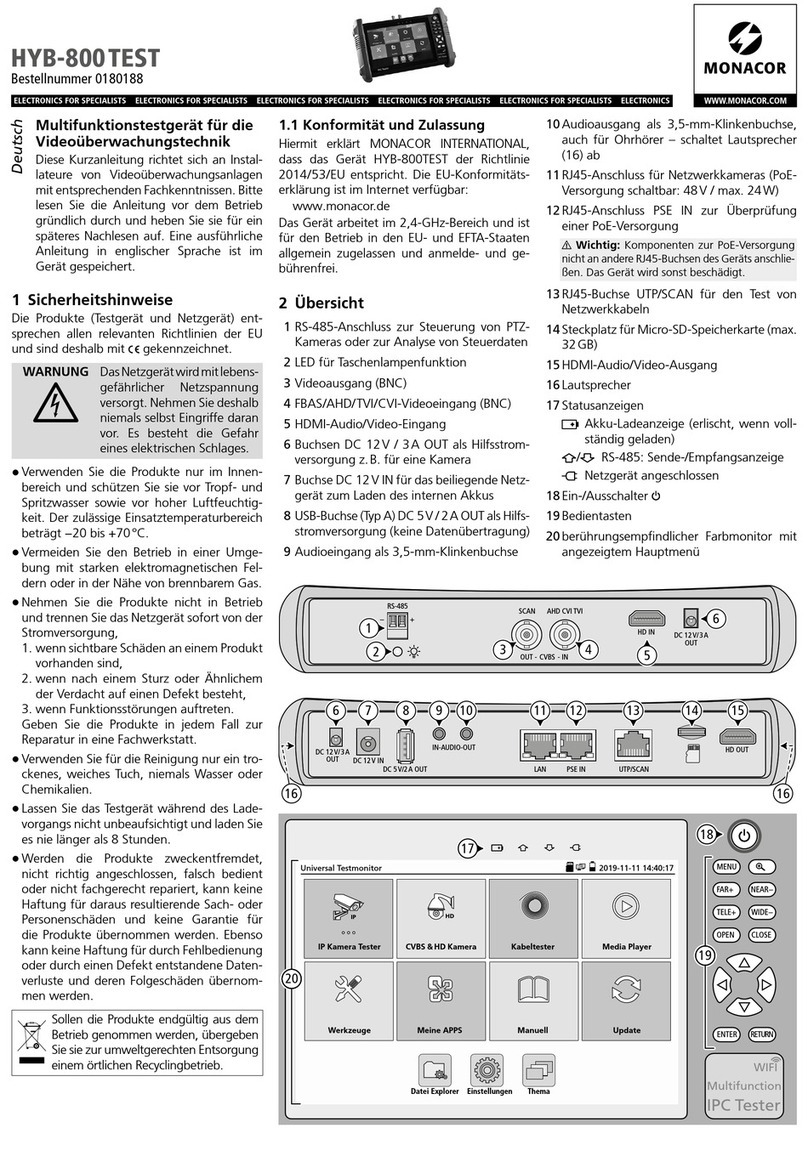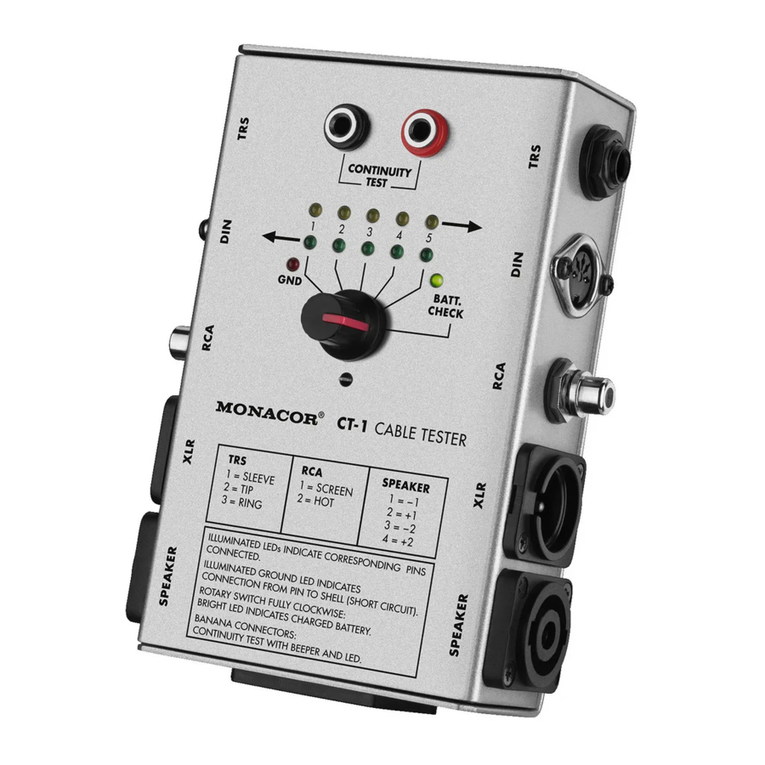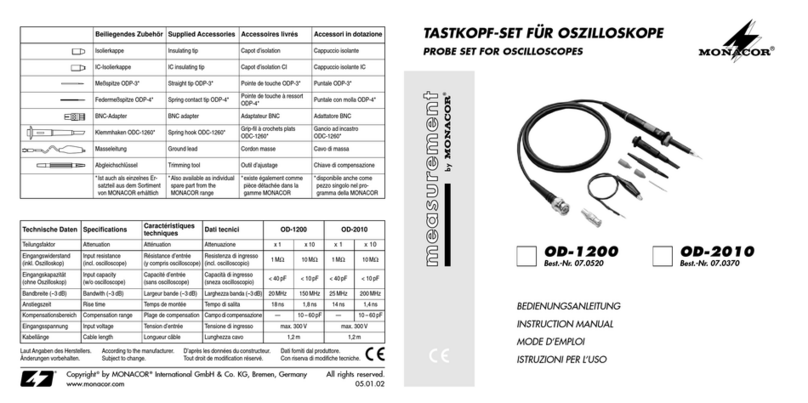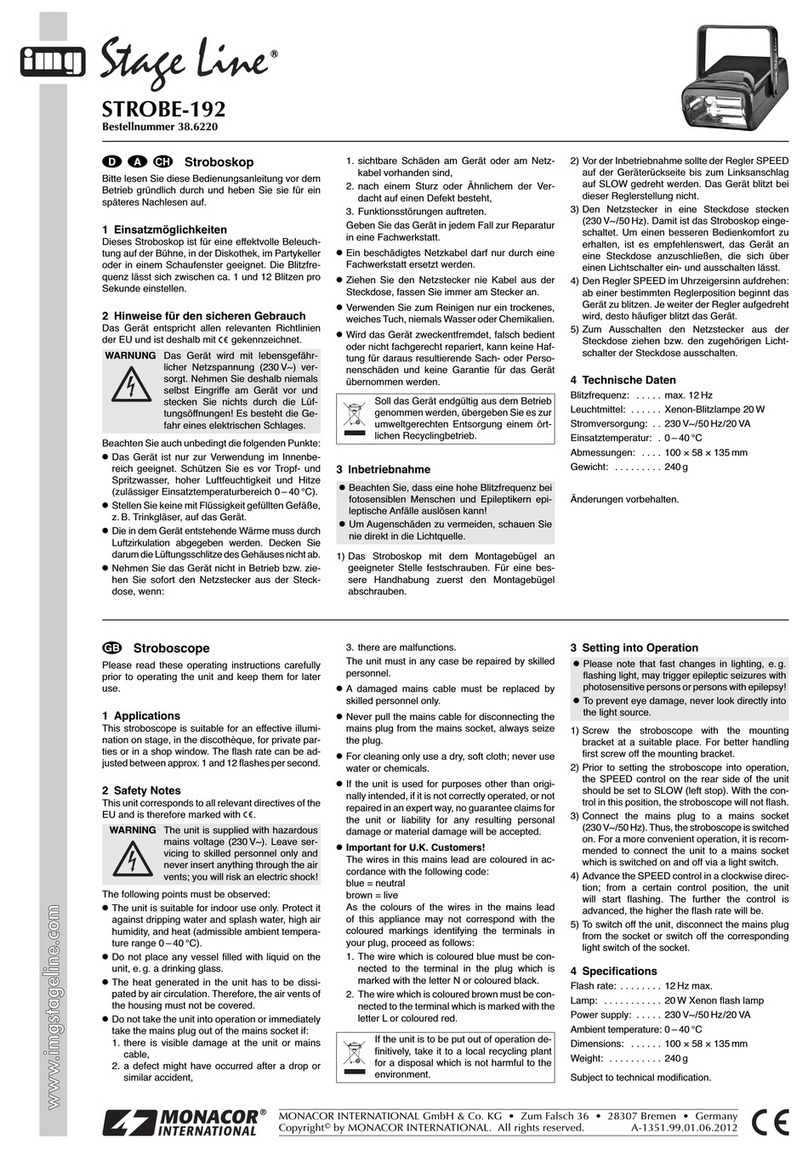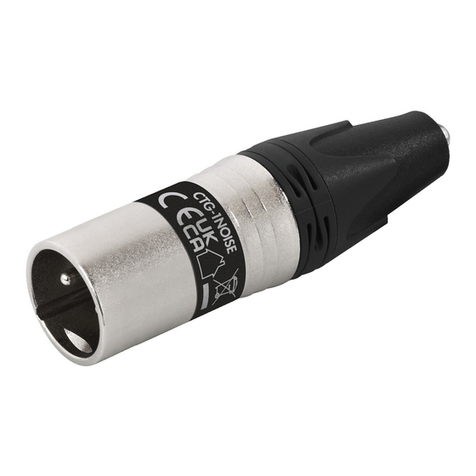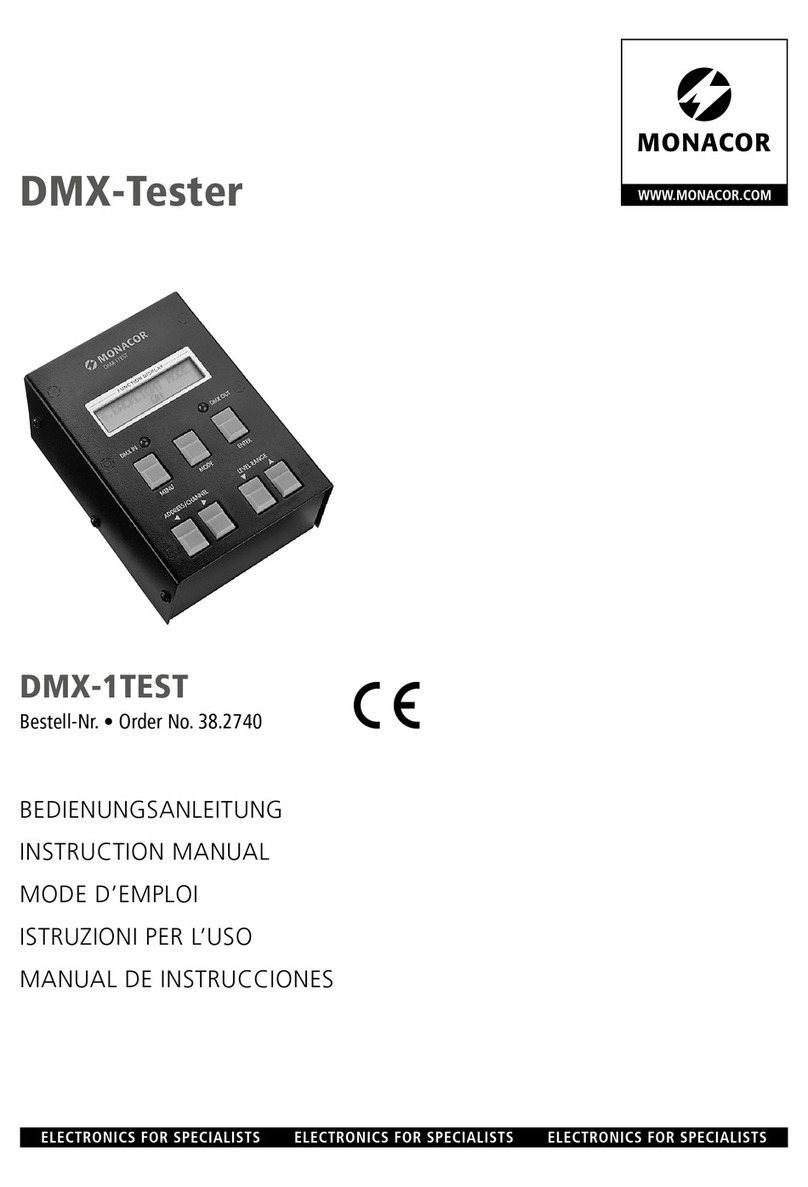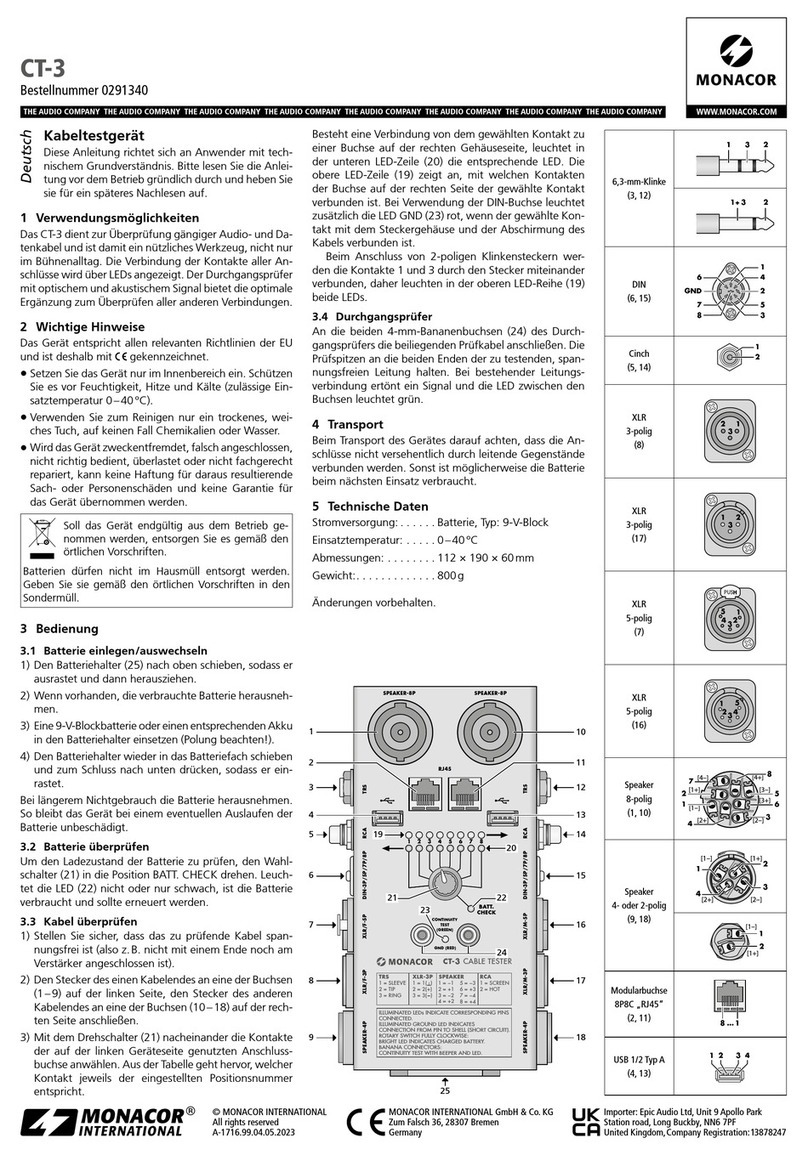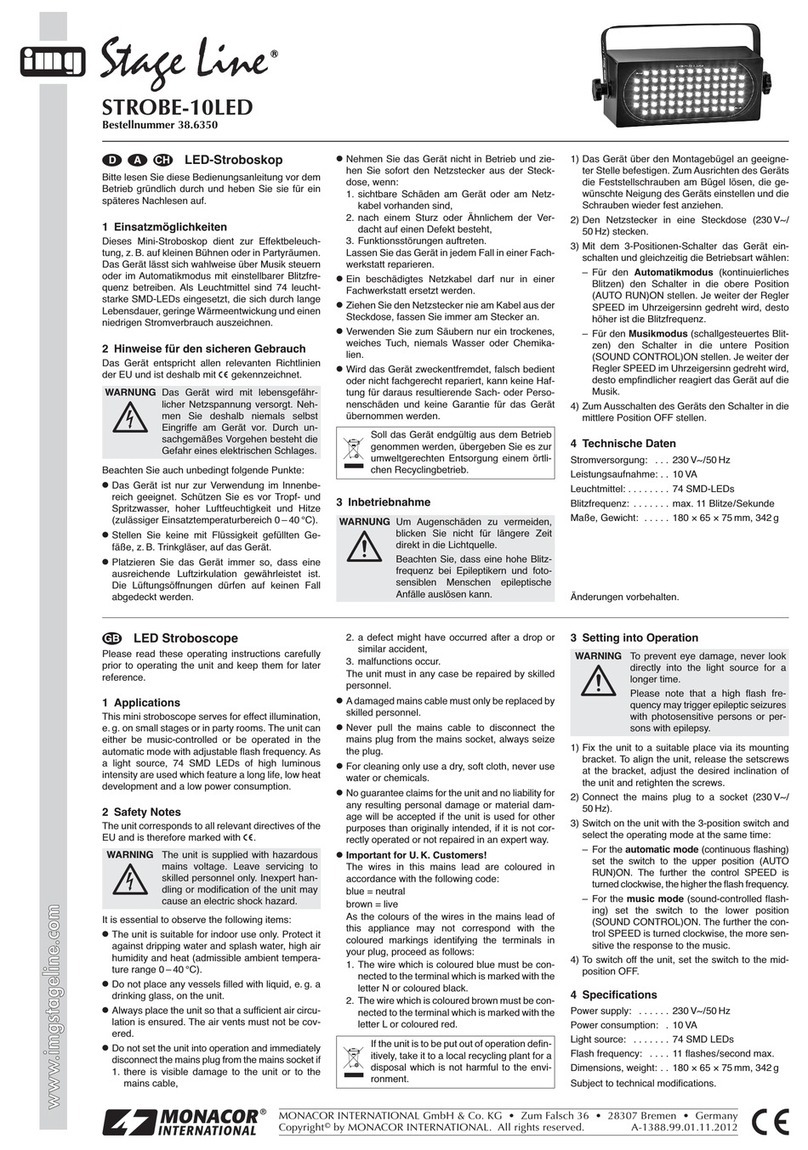
ELECTRONICS FOR SPECIALISTS ELECTRONICS FOR SPECIALISTS ELECTRONICS FOR SPECIALISTS ELECTRONICS FOR SPECIALISTS ELECTRONICS FOR SPECIALISTS ELECTRONICS
MONACOR INTERNATIONAL GmbH & Co. KG • Zum Falsch 36 • 28307 Bremen • Germany
Copyright©by MONACOR INTERNATIONAL. All rights reserved. A-1716.99.03.02.2017
SPEAKER-4P XLR-/F-3P XLR/F-5P DIN-3P/5P/7P/8P
SPEAKER-4P XLR-/M-3P XLR/M-5P DIN-3P/5P/7P/8P
ILLUMINATED LEDs INDICATE CORRESPONDING PINS
CONNECTED.
BANANA CONNECTORS:
CONTINUITY TEST WITH BEEPER AND LED.
ILLUMINATED GROUND LED INDICATES
CONNECTION FROM PIN TO SHELL (SHORT CIRCUIT).
ROTARY SWITCH FULLY CLOCKWISE:
BRIGHT LED INDICATES CHARGED BATTERY
.
SPEAKER-8P SPEAKER-8P
2 345
1 6 7 8
TRS
TRS
RJ 45
RCA
RCA
BATT.
CHECK
TRS
1 = SLEEVE
2 = TIP
3 = RING
1 = −1
2 = +1
3 = −2
4 = +2
5 = −3
6 = +3
7 = −4
8 = +4
SPEAKER RCA
1 = SCREEN
2 = HOT
CT-3 CABLE TESTER
XLR-3P
1 = 1( )
2 = 2(+)
3 = 3( )
GND (RED)
CONTINUITY
TEST
(GREEN)
3
4
2
1
12
11
10
5
13
14
615
8 17
716
9 18
19
21
23
24
22
20
Testeur de câbles
Cette notice s‘adresse aux utilisateurs avec des
connaissances techniques de base. Veuillez lire la pré-
sente notice avec attention avant le fonctionnement
et conservez-la pour pouvoir vous y reporter ultérieu-
rement.
1 Possibilités d’utilisation
Le CT-3 permet de vérifier des cordons audio et de don-
nées, c‘est donc un outil utile, pas seulement pour des ap-
plications quotidiennes sur scène. La connexion de tous les
contacts est indiquée par des LEDs. Le testeur de continuité
avec signal optique et acoustique propose un complément
optimal pour vérifier toutes les autres connexions.
2 Conseils importants
L’appareil répond à toutes les directives nécessaires de
l’Union européenne et porte donc le symbole .
•
L’appareil n’est conçu que pour une utilisation en inté-
rieur.Protégez-le de l’humidité, du froid et de la chaleur
(plage de température de fonctionnement autorisée :
0–40°C).
•
Pour le nettoyage, utilisez uniquement un chiffon sec
et doux, en aucun cas de produits chimiques ou d’eau.
•
Nous déclinons toute responsabilité en cas de dommages
matériels ou corporels résultants si l’appareil est utilisé
dans un but autre que celui pour lequel il a été conçu,
s’il n’est pas correctement branché ou utilisé, s’il y a sur-
charge ou s’il n’est pas réparé par une personne habili-
tée, en outre, la garantie deviendrait caduque.
Lorsque l’appareil est définitivement retiré du
service, vous devez le déposer dans une usine de
recyclage adaptée pour contribuer à son élimina-
tion non polluante.
Ne jetez pas les batteries usagées dans la poubelle do-
mestique. Déposez- les dans un container spécifique (par
exemple chez votre revendeur) pour leur recyclage non
polluant.
CARTONS ET EMBALLAGE
PAPIER À TRIER
3 Utilisation
3.1 Insertion et changement de la batterie
1) Poussez le support de batterie (25) vers le haut pour
qu‘il se désenclenche et puisse être retiré.
2) Retirez la batterie déchargée, si existante.
3) Insérez une batterie 9V ou un accumulateur correspon-
dant (attention à la polarité !).
4) Replacez le support de batterie dans le compartiment,
puis appuyez vers le bas pour qu‘il s‘enclenche.
En cas de non utilisation prolongée, retirez la batterie, elle
pourrait couler et endommager l’appareil.
3.2 Vérification de la batterie
Pour vérifier l’état de charge de la batterie, tournez le sé-
lecteur (21) sur la position BATT. CHECK. Si la LED (22) ne
brille pas ou brille trop faiblement, la batterie est morte et
devrait être remplacée.
3.3 Vérification de câble
1) Assurez-vous que le câble à tester n’est pas conducteur
de tension (par exemple assurez-vous qu’une extrémité
n’est pas encore reliée à l’amplificateur).
2) Reliez la fiche d’une extrémité du cordon à une des
prises (1 à 9) sur le côté gauche et la fiche de l’autre
extrémité du cordon à une des prises (10 à 18) sur le
côté droit.
3) Avec le sélecteur (21), sélectionnez les uns après les
autres les contacts de la prise de branchement utilisée
sur le côté gauche de l’appareil. Le tableau indique quel
contact correspond au numéro réglé de position dans
chaque cas.
S’il y a une connexion venant du contact sélectionné vers
une prise sur le côté droit de l’appareil, la LED correspon-
dante dans la ligne inférieure de LEDs (20) brille. La ligne
supérieure de LEDs (19) indique avec quels contacts de la
prise sur le côté droit, le contact sélectionné est relié. Si
vous utilisez la prise DIN, la LED GND (23) brille en rouge
en plus si le contact sélectionné est relié avec le corps de la
fiche et au blindage du câble.
Si vous branchez des fiches jack 6,35 2 pôles, les contacts
1 et 3 sont reliés ensemble par la fiche, par conséquent les
deux LEDs dans la ligne supérieure (19) brillent.
3.4 Testeur de passage
Reliez les cordons test livrés aux deux prises banane 4 mm
(24) du testeur de continuité. Maintenez les pointes de
touche aux deux extrémités du cordon à tester ne portant
pas de tension. Lorsque la connexion est établie, un signal
retentit, la LED entre les prises brille en vert.
4 Transport
Lors du transport de l’appareil, assurez-vous que les
connexions ne soient pas reliées par inadvertance par des
objets conducteurs. Sinon, la batterie pourrait être morte
lors de la prochaine utilisation.
5 Caractéristiques techniques
Alimentation :. . . . . . . . . batterie, type 9 V
Température fonc. :. . . . . 0–40°C
Dimensions :. . . . . . . . . . 114 × 190 × 60mm
Poids :. . . . . . . . . . . . . . . 800g
Tout droit de modification réservé.
Jacks 6,35
(3, 12)
1 3 2
1+ 3 2
DIN
(6, 15) 5
1
4
7
8
6
2
3
GND
RCA
(5, 14)
1
2
XLR
3 pôles
(8)
2 1
3
XLR
3 pôles
(17)
1 2
3
XLR
5 pôles
(7)
1
5
4 2
3
PUSH
XLR
5 pôles
(16)
1
2 4
5
3
Speaker
8 pôles
(1, 10)
[4
-
][4+]
[2+]
[3
-
]
[3+]
[1
-
]
[1+]
[2
-
]
1
2
7
4
6
5
8
3
Speaker
4 ou 2 pôles
(9, 18)
4[2
-
][2+]
2
1
[1
-
] [1+]
3
2
1
[1
-
]
[1+]
Prise modulaire
8P8C « RJ45 »
(2, 11) 1…8
USB 1/2 type A
(4, 13)
1 2 3 4
CT-3 Référence numérique 29.1340
Français
